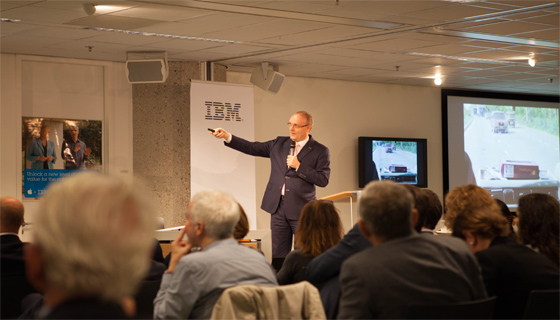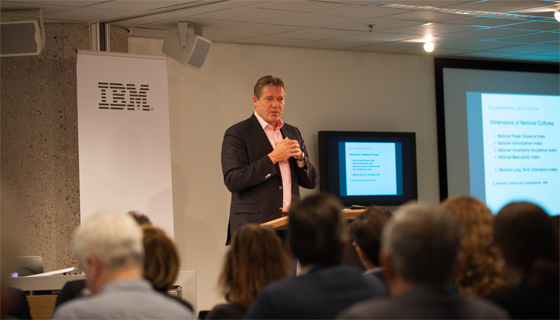Generic
Celebrating 10 years of Corporate Service Corps
03/10/2017 | Written by: Warner Dijkhuizen
Categorized: Generic
Share this post:
For English translation, see below
Terug op het blauwe nest
Afgelopen week kwam de historie weer tot leven toen Professor Geert Hofstede ter gelegenheid van de 10e verjaardag van het IBM Corporate Service Corps programma en het 50-jarig bestaan van Hofstede Insights Instituut (voorheem ITIM) op het IBM Client Center het ontstaan van zijn Cultural Dimensions theorie presenteerde. De basis voor deze inmiddels wereldwijd bekende methode werd in 1961 gelegd op dezelfde plaats: de IBM schrijfmachinefabriek aan de Johan Huizingalaan in Amsterdam.
Mede door zijn onderzoek kon hij in 1965 bij IBM in dienst komen als “personal research profesional” bij het IBM executive training centrum Blaricum. Data uit de toen net ingevoerde “opion surveys” in combinatie met gegevens die hij als professor bij IMD business school verzamelde over internationale studenten tijdens zijn sabatical bood hem inzicht in de verschillen in denkwijze per land: de nationale culturen.

Dit inzicht heeft hij later bij IMD verder ontwikkeld tot de bekende Cultural Dimensions, met eerst 4 en inmiddels 6 assen waarmee een cultuur wordt gekenmerkt. De inmiddels 89-jarige professor blikte na 50 jaar terug op zijn academische carriere en voelt zich -ook na zo’n lange tijd- nog steeds “IBMer” in hart en nieren.
Het leven gered
IBMer George Duits schetste op levendige wijze hoe het boek “Cultures and organizations: software of the mind“ op zijn CSC assignment van pas kwam, en op zijn vele reizen hem zelfs verscheidene keren heeft gered.

Bart Fehmers gebruikte zijn internationale ervaringen om op beeldende wijze de Hofstede dimensies te illustreren. Mooie voorbeelden zoals het verschil in lange- en kortetermijndenken tussen Oost en West, het verschil tussen de directe en indirecte manier van communiceren en het belang van gezichtsbehoud bij onderhandelingen gaven aan hoe lastig cultuurverschillen onderhandelinge kunnen maken.

Dat ook hier de praktijk vaak weerbarstiger is dan de theorie, werd door Anand Pultoo en Karin Faase in een ontwapend eerlijk en zeer leerzaam verslag van hun opdracht bij een grote IBM klant duidelijk. De “lessons learned” en met name zijn slotconclusie “Financial results tell how successful you’ve been in the past, cultural will determine whether I’m successful in the future” maakte bij velen grote indruk.
De breakout sessies in de middag belichtten cultuur en culturele verschillen vanuit uiteenlopende standpunten, allemaal zeer de moeite waard en vol met memorable lessen. De sessie met Geert-Jan Hofstede en Bart Somers over het overbruggen van culturele verschillen en benadrukken van de overeenkomsten liet niemand onberoerd en was een prachtige afsluiting van deze bijeenkomst.
Op de Hofstede Insights facebookpage staat een livestream van een aantal presentaties
Meer informative over het IBM CSC programma vind je hier
English summary
Last week history came to life again when Professor Geert Hofstede presented the development of his Cultural Dimensions theory on the 10th anniversary of the IBM Corporate Service Corps and the 50th anniversary of the Hofstede Insights Institute (former ITIM) at the IBM Client Center. The foundation for this, now world-wide known, method was laid in 1961 at the very same place: the IBM typewriter factory at the Johan Huizingalaan in Amsterdam.
A few years later, his research work brought him back again to IBM where he started as a “personal research professional” at the Executive Training Center in Blaricum. Data from the, at that time gradually, introduced “opinion surveys” in combination with data he collected as a professor from international students of IMD business school during his sabbatical provided him with insights into the different ways of thinking per country: the national cultures. These insights were the base for the Cultural Dimensions theory, first with 4 and now 6 axes that characterize a culture. The 89-year-old professor looked back at his academic career after 50 years, but even after such a long time, he still felt “IBMer” in heart and soul.
IBM’s George Duits introduced Geert Hofstede with a vivid sketch on how the book “Cultures and organizations: Software of the Mind” helped him during his CSC assignment. Bart Fehmers illustrated the Hofstede dimensions with examples from his international career in IBM. Like the difference between long-term and short-term thinking between East and West, the difference between the direct and indirect way of communicating and the importance of face retention in negotiations.
To put all this in practice is often harder than one may think from the books. Anand Pultoo and Karin Faase made this clear in an honest and very instructive account of their assignment with a major IBM customer. The lessons learned, and -in particular- the conclusion “Financial results tell how successful you’ve been in the past, but culture will determine whether you are successful in the future” had a great impact.
The breakout sessions in the afternoon shone a light on culture and cultural differences from various angles, all very worthwhile and full of memorable lessons. The closing session with Geert-Jan Hofstede and Bart Somers (mayor of Mechelen, Belgium) on his successful programs to bridge the cultural differences and to emphasize the similarities left no one untouched and was a wonderful conclusion off this very special day at IBM.
You will find a livestream of some presentations on the Hofstede Insights on Facebookpage and more information on the IBM CSC programme can be found here.

Corporate Citizenship & Corporate Affairs manager bij IBM
Is regulation enabling or hindering innovation in the financial services industry?
Anne Leslie, Cloud Risk & Controls Leader Europe, IBM Cloud for Financial Services Europe’s financial services sector is in the throes of wide scale digital transformation – a transition being accelerated by the growing adoption of digital solutions and services to help keep up with the demands of digitally savvy consumers. While there can be […]
The Digital Operational Resilience Act for Financial Services: Harmonised rules, broader scope of application
The Digital Operational Resilience Act – what and why As part of the European Commission’s Digital Finance Package, the new Digital Operational Resilience Act, or in short DORA, will come into force in the coming period. The aim of DORA is to establish uniform requirements across the EU that improve the cybersecurity and operational resilience […]
Banking on empathy
Suppose you’re owning a small boutique wine shop and have gone through two difficult years because of the Covid-19 pandemic. As the pandemic seems to be on its way back, it is time to revitalize the shop. And this causes direct a huge challenge: the wine stock needs to be replenished but you have used […]


